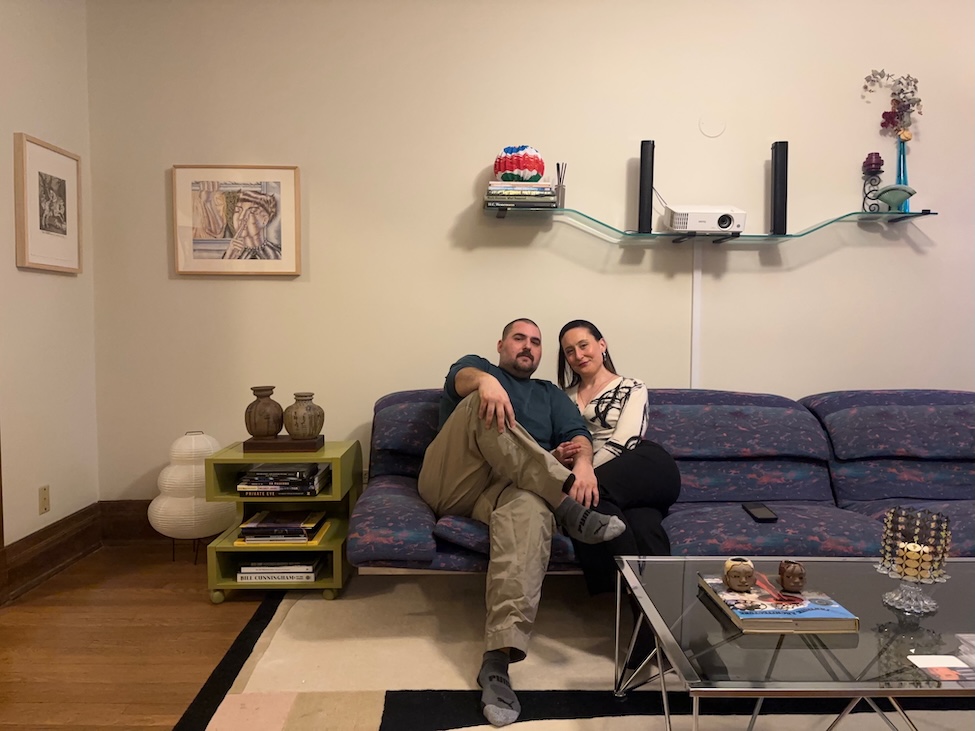Hurvin Anderson's Artistic Translations at The Arts Club of Chicago


By JACQUELINE LEWIS
As The Arts Club prepared this past March to open its third exhibition since the arrival of the pandemic, Anywhere But Nowhere, by 2017 Turner Award nominee Hurvin Anderson, I sat down with the club’s Executive Director and Chief Curator Janine Mileaf to discuss Anderson’s new works, the artist’s ongoing barbershop theme, as well as the challenges involved with successfully mounting an international exhibition during the time of COVID-19.
I was also fortunate to connect with Mr. Anderson for this interview, and he graciously added deeper insight to this exhibition in regards to his identity as a British-born artist, one step removed from his familial homeland in Jamaica.
CGN: How did the Arts Club begin collaborating with Hurvin Anderson?
Janine Mileaf: This exhibition has been on the books for quite some time. It was supposed to take place about a year ago, but the pandemic postponed it. I had met the Hurvin Anderson and did a studio visit in London a couple years a year ago, after which I offered him a show here. He graciously accepted.
CGN: Can you give us an overview of the exhibition?
JM: The exhibition includes two series coming together: brand new paintings on the subject of Jamaica and its sites of tourism, as well as ongoing work regarding barbershops. Hurvin’s barbershop work is very well known – it’s been going on since 2005 – but he’s made brand new, significant work in that series.
By bringing the Jamaica and barbershop series together, he’s considering both his ongoing, formal aesthetic approach, while also thematically linking the two.
The barbershop series has to do with the Jamaican diaspora in Britain. Hurvin is a UK–born artist with Jamaican heritage. While growing up in Birmingham, he went to barbershops with his dad. They were a sort of cultural, makeshift space that became a Jamaican hub for him. So they are a closed, interior space of Jamaican gathering within the UK. In contrast the Jamaican spaces depicted in Hurvin’s new paintings are all exterior landscapes. He wanted to bring together these two worlds and explore how they mirror each other in this new exhibition.
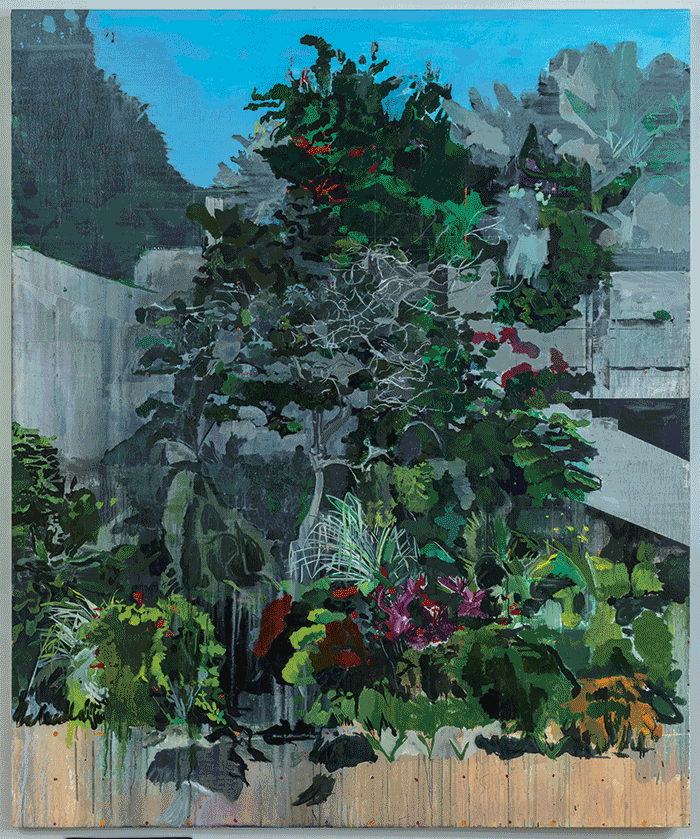
CGN: How do the works depict the dualities of development and dereliction surrounding the Jamaican tourist sites? Can you explain how they happen simultaneously?
JM: That was actually the impetus for this series of works.
Hurvin took a bunch of photographs when he went to Jamaica in 2017. He was struck by the sites where he would see giant construction projects adjacent to places that were falling apart. There was this investment in the new without care for the existing. It struck him as problematic, so he focused on it visually.
In the paintings, you don’t necessarily see the cranes and the active building, but you see a hotel site that’s built in limestone. He focuses on this perforated stone wall covered in foliage, and you cannot tell if it’s being built or torn down. There’s this constant need for redevelopment, growth and construction, but at the same time there’s neglect and decay.
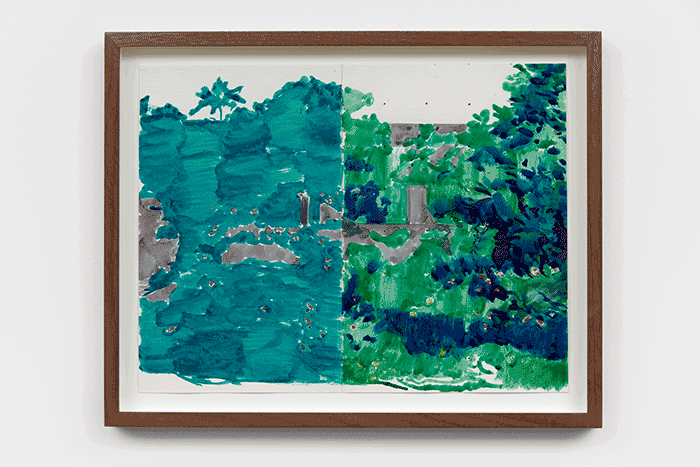
CGN: What does the title “Anywhere but Nowhere” mean?
JM: The title itself comes from a KC White reggae song of the same name. There are a lot of musical references in the titles of Hurvin’s works. But he’s also referencing the specificity of place – a kind of familiar view that is not specific in terms of its locale. A lot of Caribbean touristic sites are kind of treated in this same way.
There’s a monumental landscape painting in this show titled No One Remembers, and for Hurvin, it’s extremely specific in terms of Jamaican context. It’s a combination of abstract planes and signage. To him it’s the visual imagery you see all over Jamaica. For someone familiar with that it would be very recognizable.
Anywhere but Nowhere is also wrapped up in a concept of utopia Hurvin is playing with. There is this value placed on a homeland by those who are part of the diaspora, so he has a romanticized Jamaica that he’s never really lived in. He’s a foreigner there, yet he has this very close connection. There’s a paradise people get in their minds, including him, that doesn’t really exist.

CGN: How does Anderson’s British Nationality and experience intersect with his Jamaican roots in this exhibition?
JM: I actually spoke with Hurvin today, and he said that a goal of his is to merge them. In this exhibition they are still two separate things, but both are equally part of him. He wanted to see them together for structural and thematic reasons, but I think they still do remain separate.
There’s a utopian view of both places: this internal community in a broader place like the UK, and then this image of a paradise that’s externalized in the Jamaican scenes. He plays them off each other conceptually.
*
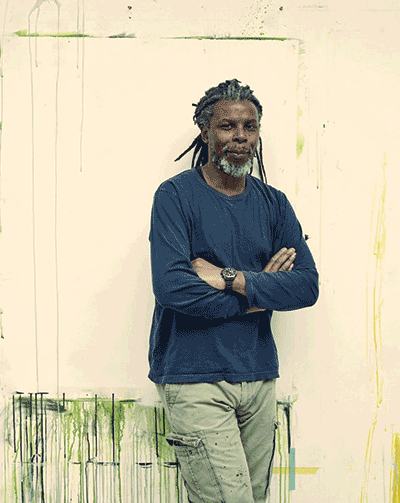
CGN: Mr. Anderson, will you please share your experience as a British citizen visiting your familial country of Jamaica?
Hurvin Anderson: In this body of work I’m offering a representation of Jamaica as told to me through two generations of the diaspora. Although based on photographs of a real location on Jamaica’s North Coast, these works are also creations of my imagination and born of a powerful oral history. As such, I am always one step removed, trying to understand the visceral pull of a homeland I’ve never known but that has been so richly described. The Jamaica of people’s memory dominated conversations in my childhood, so representing these conjured images on the canvas is, I suppose, a way of filling a loss or void. Life in Jamaica was not my experience, but in recreating a version in my own language I can, in part, relate or share in it.
The retelling of stories from Jamaica mythologised the country of my parents and siblings’ birth. On a visit in 2017, my mind was full of descriptions of the charm of the place while physically confronted with the beauty yes, but also the reality of economic hardship. The abandoned hotels became a metaphor for me for these mixed feelings of grandeur and loss, of a garden of eden, a lost city and the pain of nostalgia.
*
CGN: Since the artist is based in the UK, and international travel is difficult during the pandemic, did the Arts Club have to employ new ways to collaborate on this exhibition?
JM: Happily I had been to Hurvin’s studio long before the pandemic, and he had basically sketched out the entire exhibition. We were lucky in that way. He just had more time to work on it.
This morning we were looking at floor plans to figure out exactly where things would go, and we have FaceTime check-ins scheduled over the next couple days. We’ll do a little with the exhibition, show him virtually, and then repeat the process.
Normally he would be here at this point. We’re hoping that he may still come in person this summer for a closing event. That would be nice. We’re all working on getting vaccinated, and travel may be possible, so we haven’t written that off yet.
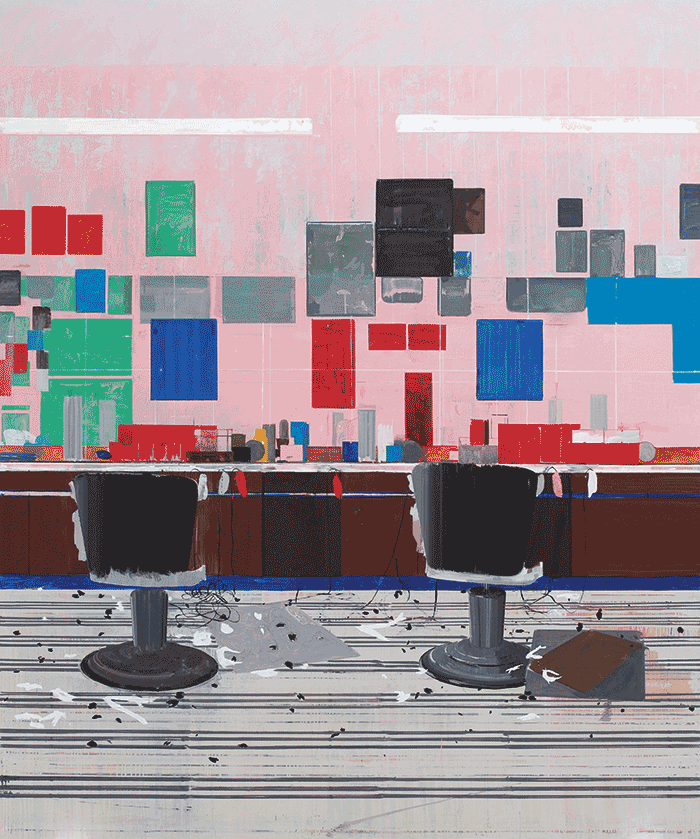
CGN: Do you think that technology like this could allow for even less separation and lead to a more interconnected, global art experience?
JM: I mean, you can get things done, depending on the planning, but the richness of the artist’s presence is very much missed.
CGN: How is The Arts Club approaching exhibiting art during an ongoing pandemic?
JM: We were closed, then open, then closed, and then open by appointment. Now with Hurvin’s exhibition, I believe that we will be able to open at regular gallery hours. We are always watching and will respond based on the city’s guidelines.
Unfortunately we cannot have a live opening, but we have been doing some public, mini tours instead of a big tour, as well as a public Zoom talk in April. In June we will have an open house with tours. Over the summer and depending on regulations, we may have another talk or event.
CGN: What aspects of the exhibition are you most excited for people to experience?
JM: I am excited for people to experience the tactile qualities of the art that you just cannot get on a screen. The scale and the embodied relationship between the viewer and the painting is also very important in these works, as well as those physical textures. There is also this structure under his paintings that reveals itself gradually, making time extremely important for his works.
Hurvin Anderson: Anywhere But Nowhere, Thru August 7, 2021 at The Arts Club of Chicago • artsclub.org

